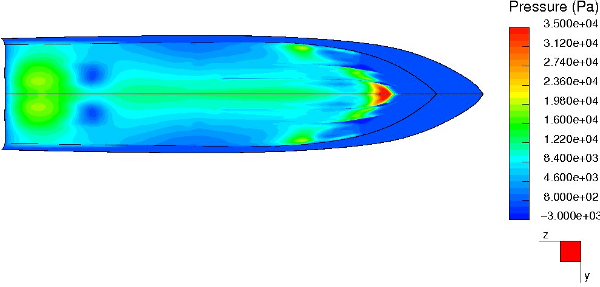Rolla SP Propellers
Via Roncaglia 6
6883 Novazzano - Switzerland

TEL:+41916952000
FAX:+41916952001
In order to design the propeller the boat resistance must be known.
The problem is with hard-chine planing craft of small and medium dimensions, where tank tests are not usually
carried out and where the available resistance prediction methods, such as the Savitsky method, are not applicable to the present hulls (because of warped shape, chine, spray rails, tunnels and flaps.)
The flow is usually characterized by a thin spray, that emerges at the bow from the stagnation line, and it becomes detached or reattached at the chine and the spray rails. There is also a complex flow at the transom whose nature depends on the speed and any breaking wave.
These sorts of problems have been successfully solved using the High Resolution Interface Capturing (HRIC) a treatment of free surface flows.
Rolla is now able to test planing hulls at any speed, and using greater accuracy than that which was used when testing with a towing tank. Thanks to HRIC Rolla can predict hull resistance, trim, and also local flow details that was not possible while using the towing tank. Flow visualization gives a better understanding of both overall and specific aspects of the boats behavior.
Rolla uses HRIC not only in order to design propellers but also to be able to offer shipyards the analysis and optimization of their boats.
Resistance prediction of displacement hulls
Displacement craft generate regular waves that produce wave resistance. Towing tanks are used to measure this resistance in the model scale and then to transpose the value to full scale.
The numerical methods, based on the panel method, can give useful qualitative information about the flow,but fail when viscous effects are relevant (i.e. at the stern) or when the wave viscous effects are relevant (i.e. at the bow). Using the CFD method the viscous flow around the hull is established, and the free surface of whatever complexity is also accurately determined using the HRIC method.
The level of accuracy of the simulation is the same as the towing tank, and the flow visualization gives a much clearer understanding of the flow phenomenon.
Pressure distribution, dynamic wetted surface, wave pattern, streamlines and wake field at the propeller disk can be easily and effectively controlled.




